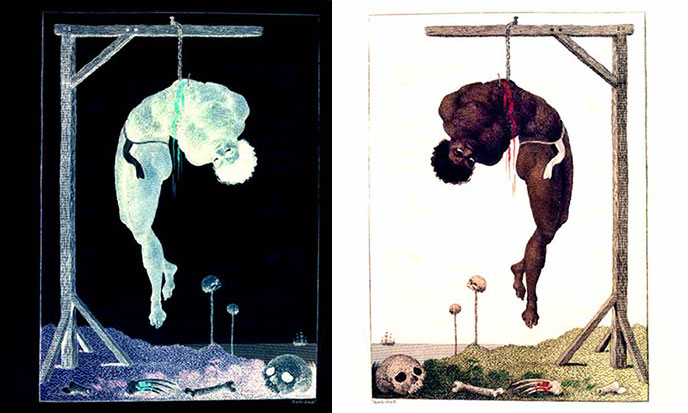
The Black Code is a set of French laws regulating the relations between the white master and his black slaves. In retrospect, these texts in their legal coldness highlight the horror of trafficking and slavery of blacks.
The preamble to the Black Code shows the concept of slavery as a fact, without giving either the origin nor the legitimization. It seems that it is absolutely contrary to French law, and so several parliaments will refuse to register the text.
The provisions of the Code
This is a code of good conduct of the master, and especially of the slave, with a whole list of sins and their punishment. Slavery is seen as an economic necessity. For every planter, a good slave is a living slave, who works hard and eats little. The Black Code has only one purpose: maximum profits and therefore minimum of trouble. It is for economic reasons that it encourages to baptize slaves, to instruct them, to provide them education and a Catholic burial.
In the first articles of the Code, its writers seem to think that blacks are human beings, endowed with a soul and likely to salvation. Ah, it’s nice. But prohibiting them to practice the Protestant faith, is it respect? Article 44 allows to doubt this: “Slaves are furniture” that is to say goods that can be sold, bought, given the will of the owner. No state of mind among farmers. Families in particular can be separated at any time.
What families, anyway?? The furniture do not have a family… If the Code gives the slave a legal personality, it is that of a minor, smaller even than that of children and servants. A child born of slave parents in turn becomes a slave. The marriage of slaves is impossible without the consent of the masters. The Code states: “If a slave married a free woman, children both male and females follow the condition of their mother.
Let’s not be happy too fast of what may appear as a humanitarian measure. The economy is never far away. The Black Code adds: “If the father is free and the mother slave, the children will be slaves equally.” The death sentence without trial is scheduled for hitting his master, for stealing a horse or cow, for the third escape attempt, or for meeting. One suspects that many abuses must have been committed… within the limits of good management, of course, of course…
![Esclaves sur le pont supérieur d'un navire (vers 1900) ; Source Conrad Alberti-Sittenfeld: Die Eroberung der Erde. (La conquête de la terre). Ullstein Verlag, Berlin, Vienne, 1909, p 225 --- [Public domain], via Wikimedia Commons --- https://commons.wikimedia.org/wiki/File:Sklaventransport.jpg esclaves-vers-1900-bateau-688po](https://eden-saga.com/wp-content/uploads/esclaves-vers-1900-bateau-688po.jpg)
If it is prohibited to torture slaves, the master has a disciplinary power: “Will be able only masters, when they believe that their slaves deserve it, have them chained and beaten with rods or ropes.” For more serious sentences, a judgment will be necessary. Thus, the amputation of an ear or a “hock”, hot branding of the lily flower or even death may be pronounced by a magistrate and performed by an executioner, not by the master himself.
On the other hand, the sentencings of masters for the murder or the torture of slave will be very rare, as you might expect. If the text forces the master to feed and clothe his slaves, it prohibits slaves to cultivate for their own account any piece of land. Moreover, if the slave has the right to complain, his testimony is not considered. He has a legal capacity lower than that of a minor. The African slave is less free than a medieval serf.
There is little doubt that the slaves had no social security. They looked after themselves as they could and died in large numbers from exhaustion or malnutrition. Article 27 seeks to provide a minimum protection to the slave, especially for old age or illness. It seems that the simple abandonment of an old or sick slave however remained the rule, without any legal proceedings, as only one sentence was recorded. (source)Louis Sala-Molins, citing Peytraud, Wikipedia
The black slaves had no right to carry weapons, except for hunting. In the first escape attempt, the maroon negro captured had his ears cut off and was branded. The second attempt resulted in cutting the hock. The third attempt was punished with death by hanging.

The Black Code is “the most monstrous legal text that the Modern Times have produced”. (source)Louis Sala-Molins, Wikipedia Anyway, this is relentlessly revealing of a dominating and racist white society, which in two centuries, has not changed much.


